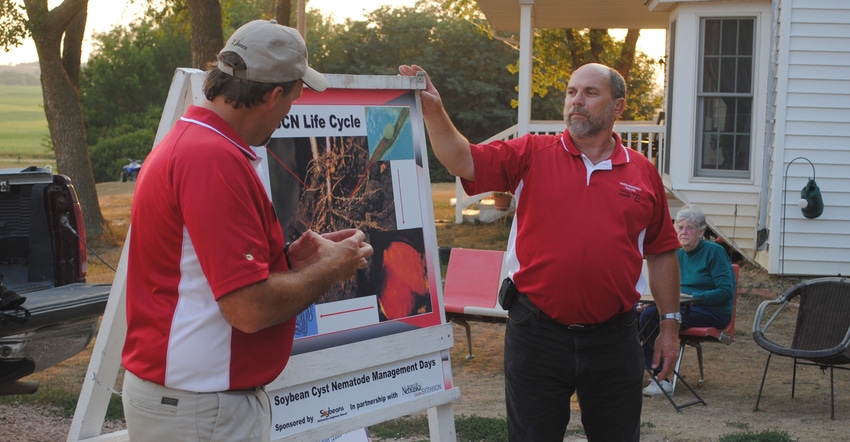
The great yield-robber, soybean cyst nematode, is one tough pest. Since SCN was first confirmed in Nebraska in Richardson County in 1986, it has spread to 59 counties where it has been confirmed, accounting for 93% of Nebraska’s soybean production.
The silent pest annually robs Nebraska soybean growers of $40 million or more in lost yield and crop revenue, and between $1.5 billion and $2 billion across the U.S.
Now, researchers are finding that this tough pest is getting tougher. A recent survey in Nebraska showed that 47% of fields tested had SCN populations that reproduced above acceptable levels on PI 88788, the most commonly available source of resistance in SCN-resistant soybean seed on the market. In at least three other states, that number is more than 90%. This higher level of reproduction allows SCN numbers to increase even where SCN-resistant varieties are planted.
“Initially, when we started promoting SCN management practices in the 1990s, the theme was ‘Take the test, beat the pest,’” says John Wilson, Nebraska Extension educator and SCN specialist. “We advised farmers to test fields that had never been tested if they suspected SCN as the cause of unusual yield losses, to find out if SCN was there,” he says. “If it was there, we advised farmers to use resistant varieties in soybeans and rotate soybeans with a non-host crop.”
Looking past PI 88788
Almost all commercially available SCN-resistant soybean varieties have PI 88788 as the source of resistance, so SCN in those fields where that source has been utilized over the past few years has become resistant. This has led Nebraska Extension researchers to develop new recommendations for managing high SCN populations.
“There are more resistant soybean varieties to choose from today, compared to the early 1990s, when there was a tremendous yield drag on resistant varieties,” Wilson says. “Today, the SCN-resistant varieties are some of the highest yielding, thanks to the work of seed companies and their breeding programs.”
SCN resistance is developed through natural breeding and is not a GMO process, he adds.
“Since we’ve used the same source of resistance over and over, populations have become resistant,” Wilson explains. “The reduction in SCN reproduction from resistant varieties might range greatly between fields and even between varieties on the same populations, so using those varieties is still better than using a susceptible variety.”
The increasing populations in fields where resistant varieties are being used has led to recommendations for retesting fields about every six years to compare SCN levels with the last time the field was tested.
“There is nothing magical about the six years,” Wilson says. “If you have corn-on-corn in the field, wait until the seventh year to test.”
Producers can test at any time of the year, but most tests are taken in the fall after soybean harvest.
“Be sure to retest a field at the same time of year and after the same crop as you first tested it,” Wilson recommends. “That way it is a true comparison, because populations will fluctuate with different times of the year and the growing season. If you first tested after soybeans, retest after soybeans. If you first tested after corn, retest after corn.”
If SCN populations are found to be increasing, producers should consider planting a resistant variety with a new source of resistance, like Peking. The problem is that only 2% of the commercially available resistant seed on the market have another source of resistance like Peking that is not PI 88788. “There are some very good Peking varieties,” Wilson says. “But they are few and far between.”
Stacked sources of resistance are fine. “You’ll have to ask your seed dealer about the sources, read the seed literature, or find the information on the seed company website,” he says.
Plant non-host crop
Another way to combat SCN is to plant the field to a non-host crop like corn, milo or wheat. “The biggest reduction in SCN occurs through natural mortality the first year to a non-host crop,” Wilson says. “It’s a little less the second year.”
If the fall SCN test shows 16,000 eggs per 100 cubic centimeters of soil, soybeans shouldn’t be planted for a second subsequent year. Following corn, if the fall test shows 12,000 eggs per 100 cc, soybeans shouldn’t be planted, he recommends.
If a field is tested or retested and has considerably higher SCN populations than the thresholds, Wilson says it might be a good idea to plant the field to alfalfa if that fits into an operation. The soil would then have four or five years without an SCN host, before planting the field back to soybeans.
If alfalfa is not a valid option, producers might choose to plant some other non-host crop for another year or two years; then retest the field to see if the numbers are under the threshold of 12,000 eggs per 100 cc before rotating back to soybeans.
Learn more by visiting the SCN Coalition and Nebraska SCN. Or contact Wilson at [email protected].
About the Author(s)
You May Also Like






